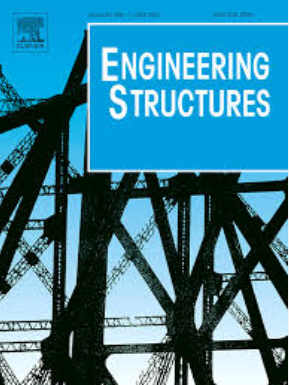Behavior of FRP seawater sea-sand ECC composite slabs under different loading conditions
IF 5.6
1区 工程技术
Q1 ENGINEERING, CIVIL
引用次数: 0
Abstract
The combination of seawater sea-sand engineered cementitious composites (SS-ECCs) and the fiber-reinforced polymer (FRP) is a new type of structural form that overcomes the defects of reinforced concrete (RC) structures, such as the difficulty in obtaining raw materials and susceptibility to corrosion constructions of offshore islands and reefs. This study proposed a new type of FRP SS-ECC composite slab that uses FRP profiles as the bottom mold and bottom tension component and replaces traditional concrete with the SS-ECC. The slabs were tested under different loading conditions, including four-point bending, center single-line loading, and single-point loading at different locations. The load-deflection response, damage pattern, strain characteristics, and energy absorption were analyzed. The load-bearing capacity of the composite slab was the highest under the four-point bending condition. Single-point eccentric loading was a more unfavorable working condition for the composite slab, wherein the slab consumed less energy and failed earlier. The varying degrees of shear tearing of the side plate of the FRP profile were the main causes of specimen failure. The longitudinal strain changes in the FRP profile at the bottom were uniform, whereas the force conditions, strain variations, and distributions of T-ribs and GFRP bars varied considerably depending on the loading conditions. Composite slabs did not have the same ductility as RC slabs, and their energy absorption was lower than that of RC slabs. However, the bearing capacity of composite slabs was significantly greater than that of RC slabs, and composite slabs exhibited a large residual bearing capacity after peak failure.
求助全文
约1分钟内获得全文
求助全文
来源期刊

Engineering Structures
工程技术-工程:土木
CiteScore
10.20
自引率
14.50%
发文量
1385
审稿时长
67 days
期刊介绍:
Engineering Structures provides a forum for a broad blend of scientific and technical papers to reflect the evolving needs of the structural engineering and structural mechanics communities. Particularly welcome are contributions dealing with applications of structural engineering and mechanics principles in all areas of technology. The journal aspires to a broad and integrated coverage of the effects of dynamic loadings and of the modelling techniques whereby the structural response to these loadings may be computed.
The scope of Engineering Structures encompasses, but is not restricted to, the following areas: infrastructure engineering; earthquake engineering; structure-fluid-soil interaction; wind engineering; fire engineering; blast engineering; structural reliability/stability; life assessment/integrity; structural health monitoring; multi-hazard engineering; structural dynamics; optimization; expert systems; experimental modelling; performance-based design; multiscale analysis; value engineering.
Topics of interest include: tall buildings; innovative structures; environmentally responsive structures; bridges; stadiums; commercial and public buildings; transmission towers; television and telecommunication masts; foldable structures; cooling towers; plates and shells; suspension structures; protective structures; smart structures; nuclear reactors; dams; pressure vessels; pipelines; tunnels.
Engineering Structures also publishes review articles, short communications and discussions, book reviews, and a diary on international events related to any aspect of structural engineering.
 求助内容:
求助内容: 应助结果提醒方式:
应助结果提醒方式:


